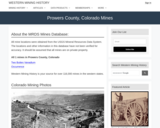
In order to give Introductory Geology (Physical Geology) undergraduate non-majors students experience and confidence in using basic algebra to calculate very simple stream flow properties, we use a prework assignment prior to the Rivers and Streams Lab. Prework is a worksheet assigned 2 weeks in advance, which asks students to calculate velocity and discharge as well as unit conversions and calculations of stream load. The questions are put into the context of activities they completed earlier in the semester during visits to the stream (on campus) so questions are relevant to their previous experiences. The prework timeframe gives students the opportunity to seek extra help from their instructor prior to the lab period in which they will make additional measurements, similar calcualations and interpretations of their data.
(Note: this resource was added to OER Commons as part of a batch upload of over 2,200 records. If you notice an issue with the quality of the metadata, please let us know by using the 'report' button and we will flag it for consideration.)
- Subject:
- Biology
- Earth and Space Science
- Hydrology
- Life Science
- Mathematics
- Measurement and Data
- Statistics and Probability
- Material Type:
- Activity/Lab
- Module
- Provider:
- Science Education Resource Center (SERC) at Carleton College
- Provider Set:
- Teach the Earth
- Date Added:
- 08/26/2019

